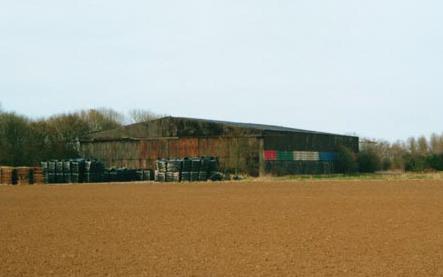Navigation
Breighton airfield, Yorkshire, England
Work on Breighton airfield started in 1941 and came to completion by the end of the year. It was opened in January 1942. As was the norm, it was standard pattern airfield, although the runways, instead of concrete, were paved
Drive through Breighton village and you can't help but notice some pretty old looking buildings scattered around. These are what remains of RAF Breighton's technical site, part of the bomber base that was situated on this very spot during the Second World War. To the north of the main grass runway (runway 11/29) you can still see an original 'T2' specification hangar (pictured left - the same hangar is visible top centre of the picture above). This was once used to accommodate the big Handley Page Halifax and Avro Lancaster bombers whilst the engineers and fitters repaired and serviced them. There were originally three of these huge buildings at Breighton but only one now remains and that is used for storage rather than fixing aeroplanes.
In June 1943 the airfield was transferred to 4 Group Bomber Command and became home to No 78 Squadron RAF equipped with Handley Page Halifax Bombers.
Breighton airfield anno 1943
Breighton airfield anno 2024
only the southern green air-strip is in use.
*Pundit Codes To assist crews in finding their base, each airfield was given mobile beacon which would flash the airfields Pundit Code ( identity code ) high into the sky at night using Morse Code by way of a red light situated up to 5 miles from the airfield. The letter code for Breighton was EY
No.78 Squadron RAF
Location:
1-15 September 1939: Ternhill
15 September-15 October 1939: Dishforth
15 October 1939-15 July 1940: Linton-on-Ouse
15 July 1940-7 April 1941: Dishforth
7 April-20 October 1941: Middleton St. George
20 October 1941-10 June 1942: Croft
10 June 1942- 16 September 1942: Middleton St. George
16 September 1942- 16 June 1943: Linton-on-Ouse
16 June 1943- 20 September 1945: Breighton
No. 78 Squadron was reformed in November 1936 from B flight of No. 10 Squadron, originally flying Heyford night bombers. By the start of the Second World War, the squadron was flying the Armstrong Whitworth Whitley Mk IV and was acting as a reserve squadron taking on pilots who had passed out from the Group Pool training units.
In the summer of 1940 the group pool training units were merged in the Operational Training Units, and No. 78 was freed to begin operations. The squadron flew its first mission on 19 July 1940.
Operations began almost immediately, the Squadron taking part in many of the major bombing raids including the attack on the top secret rocket base at Peenemünder. The Squadron also bombed gun emplacements on the French coast in support of the Allied landings on the eve of D-day in June 1944.
As the war came to a close, 78 Squadron had dropped approximately 17,000 tons of bombs and destroyed 31 enemy aircraft. They lost 182 aircraft during the 6,017 bombing and 320 mine laying sorties flown, there is a memorial dedicated to the Squadron in the graveyard just down the road at Bubwith.
The squadron remained part of Bomber Command's main bomber force until the end of the war. In March 1942 the Whitley was replaced by the Halifax, and the squadron retained that aircraft until the summer of 1945.
Aircraft type
July 1937-October 1939: Armstrong Whitworth Whitley I
June 1939-February 1940: Armstrong Whitworth Whitley IV and IVa
September 1939-March 1942: Armstrong Whitworth Whitley V
March 1942-January 1944: Handley Page Halifax B.Mk II
January 1944-April 1945: Handley Page Halifax B.Mk III
April 1945-July 1945: Handley Page Halifax B.Mk VI
William Uyen
November 18, 1943 HisStory during the Air-battle of Berlin March 31, 1944


